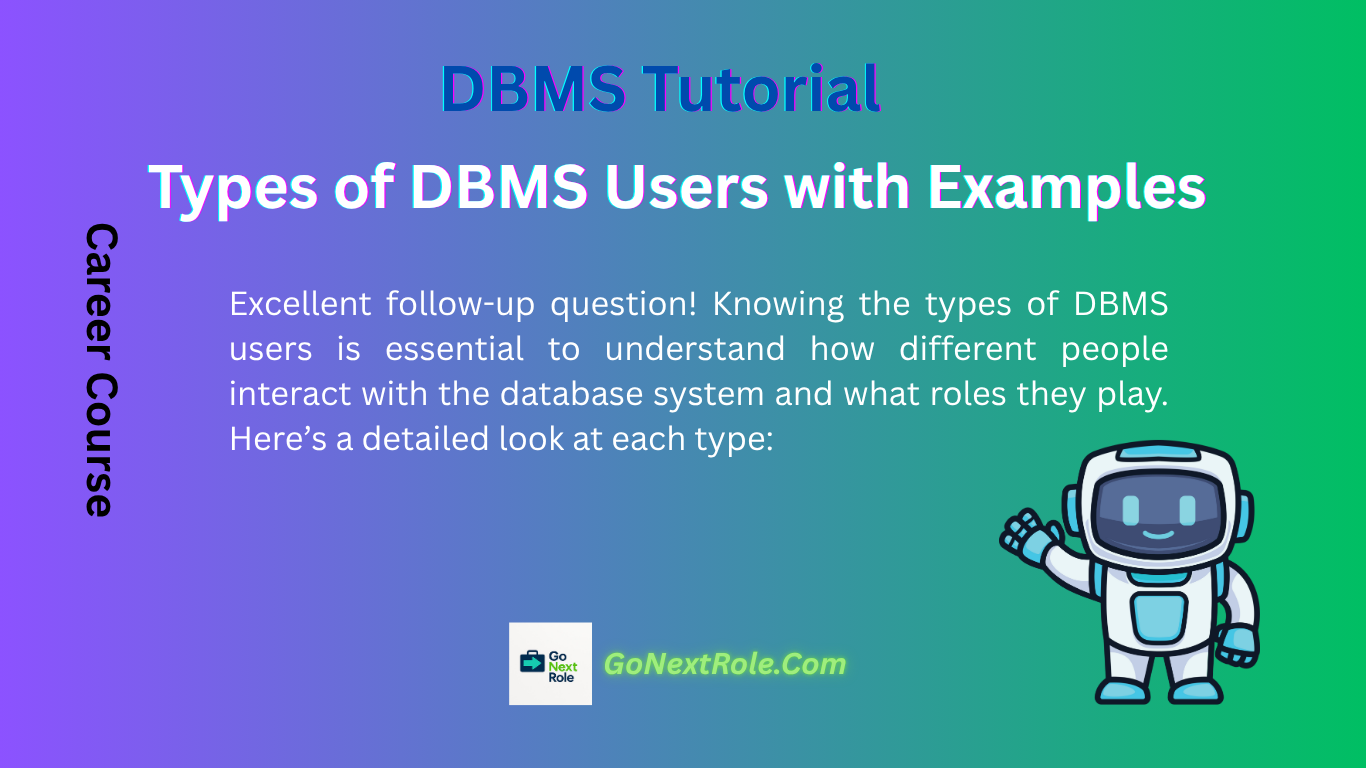Types of Data Models in DMBS – Career Course Tutorials – GoNextRole
Of course! Here’s a detailed explanation of Data Models in DBMS, covering what they are, their types, key concepts, and examples.
🌟 What is a Data Model?
A data model is a way of organizing and structuring data in a database. It defines:
✅ How data is stored
✅ How data elements relate to each other
✅ Constraints on the data
✅ How data can be manipulated
Data models provide a blueprint for designing databases and ensure consistency, integrity, and efficiency.
🔎 Types of Data Models in DBMS
Data models fall into three broad categories:
1️⃣ Object-based Data Models
These focus on the logical structure of data, and they are closer to how humans perceive data.
✅ Entity-Relationship (ER) Model
- Uses entities (things) and relationships (connections between things).
- Represented with ER diagrams.
- Components:
- Entity: object with independent existence (e.g., Student).
- Attributes: properties of an entity (e.g., RollNo, Name).
- Relationships: associations between entities (e.g., Student enrolls in Course).
✅ Object-oriented Model
- Data is represented as objects, similar to OOP.
- Supports inheritance, encapsulation, polymorphism.
- Used in object databases.
✅ Semantic Data Model
- Emphasizes the meaning (semantics) of data.
- More expressive, supporting complex data interrelationships.
2️⃣ Record-based Data Models
These describe data at a logical level but emphasize how data is stored in records (tables).
✅ Hierarchical Data Model
- Organizes data in a tree-like structure.
- One-to-many parent-child relationships.
- Example: IBM’s IMS.
- Pros: Fast access for hierarchical data.
- Cons: Poor for representing many-to-many relationships.
✅ Network Data Model
- Uses a graph structure with records connected via links.
- Allows many-to-many relationships using sets.
- Example: CODASYL DBTG model.
- Pros: More flexible than hierarchical.
- Cons: Complex design and maintenance.
✅ Relational Data Model
- Represents data in tables (relations).
- Each table has rows (tuples) and columns (attributes).
- Uses primary keys, foreign keys.
- Example: Oracle, MySQL, SQL Server.
- Pros: Simplicity, flexibility, and strong mathematical foundation.
- Cons: Performance can degrade for very complex queries.
3️⃣ Physical Data Models
- Describe how data is stored physically on storage media.
- Include details like file organization, indexes, and access paths.
- Not usually visible to end-users; important for DBMS implementers and database administrators.
🎯 Key Concepts in Data Models
- Entity: Object or concept with data stored about it.
- Attribute: Data stored about an entity.
- Relationship: Link between entities.
- Constraints: Rules that data must follow (e.g., primary key uniqueness).
- Schema: Description of the database structure.
- Instance: The actual data stored at a given time.
Types of DBMS Architecture Tutorial
Types of DBMS Users with Examples
Components of DBMS full Details
Types of Databases – (Database Management System)
DBMS (Database Management System) Tutorial
📚 Examples
- ER Model Example:
- Entities: Student, Course
- Relationship: Student registers for Course.
- Relational Model Example:
CREATE TABLE Student ( StudentID INT PRIMARY KEY, Name VARCHAR(50), Age INT ); - Hierarchical Model Example:
- Organization chart where a Manager is parent to multiple Employees.
- Network Model Example:
- In an airline database, Flights connect to multiple Bookings and Passengers with complex relationships.
✅ Why Data Models Matter
✔️ They simplify database design.
✔️ Ensure consistency and reduce redundancy.
✔️ Help developers and DBAs understand the structure.
✔️ Provide a framework for implementing and maintaining databases.
Would you like a diagram or ERD example to better visualize any of these models?



